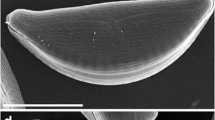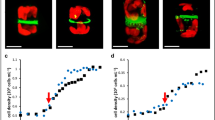Summary
The present study on a centric diatom,Ditylum brightwellii, includes two parts: detection of sugars in the silica deposition vesicle (SDV) with lectins and labeling the developing siliceous cell wall in the SDV with rhodamine 123. Cells with developing valves are treated with SDS to remove all the cytoplasmic contents, then either stained with fluorescein labeled lectins or thin-sectioned and stained with colloidal gold labeled lectins. The results show that mannose is part of the organic matrix in the SDV. Rhodamine 123, a non-toxic fluorescent laser dye, enters the cell immediately and is trapped in the SDV probably by the high reducing potential of the SDV. Silica is co-deposited with rhodamine 123 in the SDV, and the resulting valves and girdle bands become fluorescent. Implications of this study for the mechanism of silicification are discussed.
Similar content being viewed by others
Abbreviations
- SDV:
-
Silica deposition vesicle
References
Arnott HJ (1982) Three systems of biomineralization in plants with comments on the associated organic matrix. In: Nancollas GH (ed) Biological mineralization and demineralization. Springer, Berlin Heidelberg New York, pp 199–218
Bhattacharyya P, Volcani BE (1980) Sodium-dependent silicate transport in the apochlorotic marine diatomNizschia alba. Proc Natl Acad Sci USA 77: 6386–6390
Blank GS, Sullivan CW (1980) Control of silicic acid metabolism, silica valve symmetry and pattern formation during synchronized growth of the diatomNavicula pelliculosa. J Phycol 16: 5 a (abstract)
Borowitzka MA, Volcani BE (1978) The polymorphic diatomPhaeodactylum tricornutum: Ultrastructure of its morphotypes. J Phycol 14: 10–21
Coombs J, Volcani BE (1968) Studies on the biochemistry and fine structure of silica-shell formation in diatoms. Chemical changes in the wall ofNavicula pelliculosa during its formation. Planta 82: 280–292
Dawson P (1973) Observations on the structure of some forms ofGomphonema parvulum Kütz. III. Frustule formation. J Phycol 9: 353–365
Epply RW, Holmes RM, Paasche E (1967) Periodicity in cell division and physiological behaviour ofDitylum brightwellii, a marine planktonic diatom, during growth in light-dark cycles. Arch Mikrobiol 56: 305–323
Hecky RE, Mopper K, Kilham P, Degens ET (1973) The amino acid and sugar composition of diatom cell-walls. Mar Biol 19: 323–331
Johnson LV, Walsh ML, Bockus BJ, Chen LB (1981) Monitoring of relative mitochondrial membrane potential in living cells by fluorescence microscopy. J Cell Biol 88: 526–535
Li C-W, Volcani BE (1984) Aspects of silicification in wall morphogenesis of diatoms. Philos Trans R Soc Lond [Biol] 304: 519–528
— — (1985 a) Studies on the biochemistry and fine structure of silica shell formation in diatioms. VIII. Morphogenesis of the cell wall in a centric diatom,Ditylum brightwellii. Protoplasma 124: 10–29
— — (1985 b) Studies on the biochemistry and fine structure of silica shell formation in diatoms. IX. Sequential valve formation in a centric diatom,Chaetoceros rostratum. Protoplasma 124: 30–41
— — (1985 c) Studies on the biochemistry and fine structure of silica shell formation in diatoms. X. Morphogenesis of the labiate process in centric diatoms. Protoplasma 124: 146–156.
Lowenstam, HA (1981) Minerals formed by organisms. Science 211: 1126–1131
Pickett-Heaps JD, Tippit DH, Andreozzi JA (1979) Cell division in the pennate diatomPinnularia. IV. Valve morphogenesis. Biol Cell 35: 199–203
Reimann BEF, Lewin JC, Volcani BE (1966) Studies on the biochemistry and fine structure of silica shell formation in diatoms. II. The structure of the cell wall ofNavicula pelliculosa (Breb.) Hilse. J Phycol 2: 74–84
Reynolds ES (1963) The use of lead citrate at high pH as an electronopaque stain in electron microscopy. J Cell Biol 17: 208–212
Robinson DH, Sullivan CW (1987) How do diatoms make silicon biominerals? TIBS 12: 151–154
Runham NW, Thornton PR, Shaw DA, Wayte RC (1969) The mineralization and hardness of the radular teeth of the limpetPatella vulgata L. Z Zellforsch 99: 608–626
Schmid AM (1980) Valve morphogenesis in diatoms: a pattern-related filamentous system in pennates and the effect of APM, colchicine and osmotic pressure. Nova Hedwigia 33: 811–847
—, Schulz D (1979) Wall morphogenesis in diatoms: deposition of silica by cytoplasmic vesicles. Protoplasma 100: 267–288
Schnepf E, Deichgraber G, Drebes G (1980) Morphogenetic process inAttheya decora (Bacillariophyceae, Biddulphiineae). Plant Syst Evol 135: 265–277
Schulz D (1978) Silicalemma membrane pattern and valve formation of a centric diatom. In: 9th International Congress on Electron Microscopy, Toronto, vol 2, pp 410–411
Simpson TL, Volcani BE (eds) (1981) Silicon and siliceous structures in biological systems. Springer, New York Berlin Heidelberg
Spurr AR (1969) A low-viscosity epoxy resin embedding medium for electron microscopy. J Ultrastruct Res 26: 31–43
Volcani BE (1978) Role of silicon in diatom metabolism and silicification. In: Bendz G, Lindqvist I (eds) Biochemistry of silicon and related problems. Plenum Press, New York, pp 177–204
— (1981) Cell wall formation in diatoms: morphogenesis and biochemistry. In: Simpson TL, Volcani BE (eds) Silicon and siliceous structures in biological systems. Springer, New York Berlin Heidelberg, pp 157–200
Author information
Authors and Affiliations
Rights and permissions
About this article
Cite this article
Li, C.W., Chu, S. & Lee, M. Characterizing the silica deposition vesicle of diatoms. Protoplasma 151, 158–163 (1989). https://doi.org/10.1007/BF01403453
Received:
Accepted:
Issue Date:
DOI: https://doi.org/10.1007/BF01403453




